Fuel Cell Technology
-
- Siemens To Supply Fuel Cell Technology Maritime Reporter, Mar 2001 #19
The Siemens Industrial Solutions and Services Group (I&S) has been contracted to supply the most updated propulsion and automation systems (Nautos) for a trio of new submarines to be built for the Greek Navy for delivery between 2005 and 2008. The $35.5 million contract features propulsion systems that will include Permasyn permanent- field electric motors and PEM Fuel cells (polymer electrolyte membrane) as power sources. Howaldtswerke- Deutsche Werft (HDW) has been granted a contract to supply the Greek Navy with three type U 214 submarines. The first will be constructed at HDW; the remainder will be built at the Greek and Hellenic Shipyards Co. The submarines will be powered by Siemens Permasyn electric motors - permanently synchronous machines suitable for a DC power supply that are very low signatures, compact and easy to operate. PEM fuel cells as AIP systems (air independent propulsion), will power the submarines when submerged. The AIP system is produced by HDW with Siemens providing the fuel cell modules and the supervisory systems.
Circle 12 on Reader Service Card
-
- IMO 2020: Hydrogen's Future in Maritime Maritime Reporter, Jun 2019 #50
Hydrogen fuel cell technology to Satisfy Future IMO RequirementsWith an ongoing push by the maritime community to reduce ship emissions to satisfy IMO MARPOL Annex VI regulations and limit the sulfur content of ships from 01 January 2020 to 0.5 percent world-wide, many ship owners are starting to consider
-
- Cool Technology Maritime Reporter, Apr 2004 #62
power generation in many other mobile applications, including commercial and military vessels, and for rail transport. MTU is in the vanguard of fuel cell technology in Europe, and the company's developmental work on commercial marine applications has been undertaken in cooperation with Ballard, which
-
- (Fuel) Cells of Endeavor Maritime Reporter, Sep 2004 #50
German industry is doing much to advance the development and application of fuel cell technology, and is responsible for many of the initiatives launched so far in the marine sector. Although skeptics in the commercial shipping domain discount the chances of a substantial uptake of fuel cell power abo
-
- Fresh Fuel Cell Initiatives Maritime Reporter, Oct 2002 #24
European initiatives, both involving power systems supplier Wartsila Corporation, have given fresh impetus to the development and application of fuel cell technology aboard ship. The Finnish organization has entered into a pact with Danish firm Haldor Topsoe aimed at bringing cost-competitive fuel cell
-
- Marine News' Top Boats of 2021 Marine News, Nov 2021 #50
affords excellent visibility over bow loading operations. Sea Change can reach a top speed of 20.5 knots.AAM’s Wille said he believes hydrogen fuel cell technology will leapfrog traditional diesel and hybrid-electric propulsion methods as the most beneficial for maritime applications. “There are a
-
- Reduce Boatbuilding Risk by Starting with Requirements Maritime Logistics Professional, Q1 2013 #16
technology is evolving quickly as faster and bigger ships are introduced to the market. Trimarans are also gaining significant recognition. Fuel cell technology is advancing rapidly as well. Technology of this nature needs constant and careful data gathering and monitoring, and this will be vital to
-
- Electric Propulsion for Coastal Ships Maritime Reporter, Nov 2004 #72
more efficient • Less service • Natural stability possibilities • Less vibrations in the ship • Less complex hull forms possible • Ready for fuel cell technology • More redundancy possible Disadvantages • Return on investment sometimes too long • More complex systems on board • Unknown by a lot of
-
- Alternative Ferry Propulsion Systems: A Case Study Marine News, Mar 2017 #24
Battery life should be carefully evaluated. Given the rapid changes in battery technology, is a long battery life really the wisest decision? Fuel cell technology is real but the fuel is very expensive given the current sources of supply. As the hydrogen supply infrastructure develops, fuel cells will
-
- Marine Fuels: Unmasking Gas Marine News, Nov 2017 #42
, Sandia National Laboratories, set about to conduct a feasibility study to see if a realistic vessel design could be crafted to incorporate hydrogen fuel cell technology into a modern high speed passenger vessel with zero emissions. The task was further defined to ensure that the engineered concept would garner
-
- Energy Storage - Now Relevant for Any Vessel Type Marine News, Nov 2018 #76
is a benefit that has proven particularly efficient on gas engines with typically longer response time, and is believed to be a perfect partner when Fuel Cell technology comes as base load provider. There are multiple OSV's and Ferries operating today with the combination of gas engines and batteries onboard
-
- The Shipping Industry Embraces Battery Power Maritime Reporter, May 2021 #32
to fuel cells at docks.Corvus Energy is thinking along similar lines, with a late 2020 announcement that it was partnering with Toyota, to bring its fuel cell technology to the maritime sector, with plans to develop and produce Proton Exchange Membrane (PEM) fuel cell systems for the global maritime industry
-
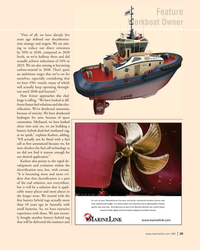 )
March 2025 - Marine News page: 29
)
March 2025 - Marine News page: 29, as we speak,” explains Karlsen, adding, “It’ll actually not be ? tted with a fuel cell as ? rst announced because we, for now, deselect the fuel cell technology as we did not ? nd it mature enough for our desired application.” Karlsen also points to the rapid de- velopment and evolution within the
-
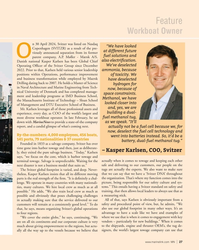 )
March 2025 - Marine News page: 27
)
March 2025 - Marine News page: 27provide a state-of-the company report, and a candid glimpse of what’s coming next. actually not be a fuel cell because we, for now, deselect the fuel cell technology and By-the-numbers: 4,000 employees, 456 boats, went into batteries instead. So, it’d be a 141 ports, 79 nationalities & 37 countries battery
-
 )
January 2025 - Marine News page: 36
)
January 2025 - Marine News page: 36St. gen as a way to get to zero emissions today in maritime.” He Johns River. A host of terminals will be getting funds to sup- stresses that the fuel cell technology “has been around for a port ‘modernization’, including the Maine Department of while,” and that Switch “… put together off the shelf equip- Transpo
-
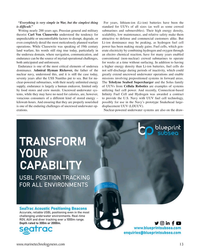 )
November 2024 - Marine Technology Reporter page: 13
)
November 2024 - Marine Technology Reporter page: 13? nity Fuel Cell and Hydrogen was awarded a contract voracious consumers of a different kind of stored energy – to provide the U.S. Navy with UUV fuel cell technology, kilowatt-hours. And ensuring that they are properly nourished possibly for use in the Navy’s prototype Snakehead large- is one of the enduring
-
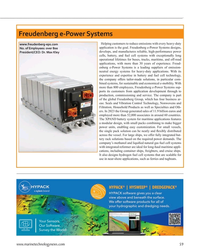 )
September 2024 - Marine Technology Reporter page: 59
)
September 2024 - Marine Technology Reporter page: 59Systems is a leading suppliers of emission- neutral energy systems for heavy-duty applications. With its experience and expertise in battery and fuel cell technology, the company offers tailor-made solutions, in particular com- bined systems, for sustainable and economical e-mobility. With more than 800
-
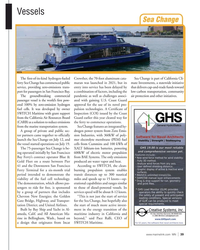 )
August 2024 - Marine News page: 39
)
August 2024 - Marine News page: 39for a six-month trial burning propulsion system enables period intended to demonstrate the transit distances up to 300 nautical viability of the fuel cell technology. miles and speeds up to 15 knots—op- The demonstration, which allows pas- erational capabilities and ranges similar sengers to ride for free
-
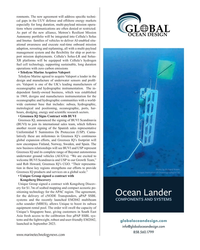 )
March 2024 - Marine Technology Reporter page: 45
)
March 2024 - Marine Technology Reporter page: 45the ? exibility for ship or port-to- port mission deployments. Cellula’s Solus-LR and Solus- XR platforms will be equipped with Cellula’s hydrogen fuel cell technology, supporting sustainable, long duration operations with zero carbon emissions • Teledyne Marine Acquires Valeport Teledyne Marine agreed to
-
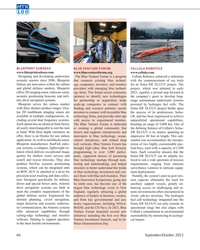 )
September 2023 - Marine Technology Reporter page: 66
)
September 2023 - Marine Technology Reporter page: 66of leaders in business, science, Arctic sub-ice missions. The hydrogen mission planning, covert navigation, and from key governmental and aca- fuel cell technology integrated into the target detection and acoustic underwa- demic organizations, including NOAA, Solus-XR XLUUV not only extends its ter communicat
-
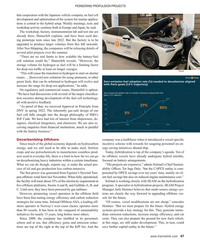 )
May 2023 - Maritime Reporter and Engineering News page: 47
)
May 2023 - Maritime Reporter and Engineering News page: 47commercial issues, Humerfelt is upbeat. “We have had discussions with several of the major classi? ca- tion societies during development of the fuel cell technology, all with positive feedback. “As proof of that, we received Approval in Principle from DNV in spring 2022. The inherently gas-safe design
-
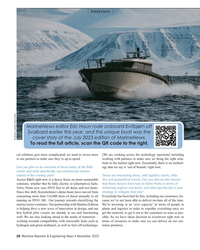 )
November 2022 - Maritime Reporter and Engineering News page: 28
)
November 2022 - Maritime Reporter and Engineering News page: 28compatibility with renewable fuels such as terms of resources to make sure we can deliver on our cus- hydrogen and green methanol, as well as fuel cell technology. tomer promises. 28 Maritime Reporter & Engineering News • November 2022 MR #11 (18-33).indd 28 11/3/2022 10:12:02 A
-
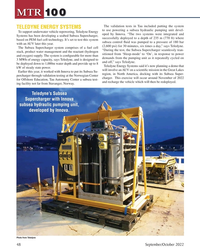 )
September 2022 - Marine Technology Reporter page: 48
)
September 2022 - Marine Technology Reporter page: 48integrated and Systems has been developing a seabed Subsea Supercharger, successfully deployed to a depth of 235 m (770 ft) where based on PEM fuel cell technology. It’s set to test this system subsea control ? uid was pumped to a pressure of 180 bar with an AUV later this year. The Subsea Supercharger
-
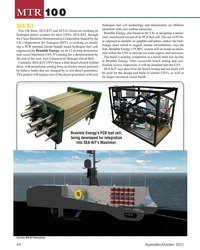 )
September 2022 - Marine Technology Reporter page: 44
)
September 2022 - Marine Technology Reporter page: 44MTR 100 hydrogen fuel cell technology and demonstrate an offshore SEA-KIT operation with zero carbon emissions. Two UK ? rms, SEA-KIT and ACUA Ocean are working on Bramble Energy, also based in the UK, is designing a marin- hydrogen power systems for their USVs. SEA-KIT, through ized, customized
-
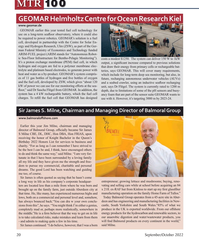 )
September 2022 - Marine Technology Reporter page: 20
)
September 2022 - Marine Technology Reporter page: 20MTR 100 GEOMAR Helmholtz Centre for Ocean Research Kiel www.geomar.de GEOMAR earlier this year tested fuel cell technology for use on a long-term sea? oor observatory, where it could also be required to power robotics. GEOMAR’s solution is a fuel cell, developed in partnership with the Centre for Solar
-
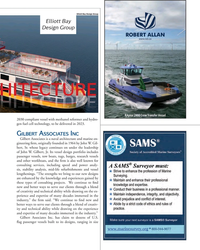 )
October 2022 - Marine News page: 49
)
October 2022 - Marine News page: 49Elliott Bay Design Group Elliott Bay Design Group 2030 compliant vessel with methanol reformer and hydro- gen fuel cell technology, to be delivered in 2023. G A IILBERT SSOCIATES NC Gilbert Associates is a naval architecture and marine en- gineering ? rm, originally founded in 1964 by John W. Gil- bert
-
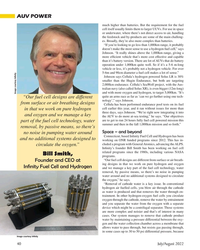 )
July 2022 - Marine Technology Reporter page: 40
)
July 2022 - Marine Technology Reporter page: 40a key the AUV to do more at-sea testing,” he says. “Our objectives are to get to run 24 hours fully fuel cell powered mission this part of the fuel cell technology, water summer and then in the fall 1,000km mission and so forth.” removal, by passive means, so there’s Space – and beyond no noise in pumping
-
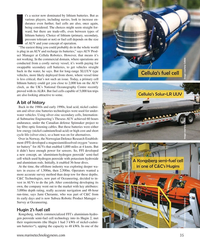 )
July 2022 - Marine Technology Reporter page: 35
)
July 2022 - Marine Technology Reporter page: 35Robotic Product Manager – Survey at Oceaneering. Hugin 2’s fuel cell Kongsberg, which commercialized FFI’s aluminium-hydro- gen peroxide semi-fuel cell technology into its Hugin 2, met their requirements (the Hugin 1 had 3 kWh of nickel-cadmi- Image courtesy Jami Cheramie Image courtesy Cellula Image
-
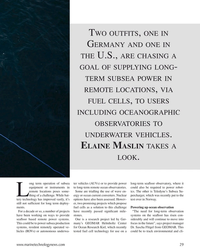 )
March 2022 - Marine Technology Reporter page: 29
)
March 2022 - Marine Technology Reporter page: 29remotely operated ve- for Ocean Research Kiel, which recently Dr. Sascha Flögel from GEOMAR. This hicles (ROVs) or autonomous underwa- tested fuel cell technology for use on a could be to track environmental and cli- www.marinetechnologynews.com 29 MTR #3 (18-33).indd 29 2/25/2022 9:34:26 A
-
 )
March 2022 - Maritime Reporter and Engineering News page: 29
)
March 2022 - Maritime Reporter and Engineering News page: 29remotely operated ve- for Ocean Research Kiel, which recently Dr. Sascha Flögel from GEOMAR. This hicles (ROVs) or autonomous underwa- tested fuel cell technology for use on a could be to track environmental and cli- www.marinetechnologynews.com 29 MTR #3 (18-33).indd 29 2/25/2022 9:34:26 A
-
 )
November 2021 - Marine News page: 51
)
November 2021 - Marine News page: 51. “It’s a beautifully built, modern looking passenger ferry to go alongside it being the ? rst of its kind in the world fully run on hydrogen fuel cell technology. Com- plete with reusable bottle ? lling stations, top of the line seating, bike racks, and a state-of-the-art pilot house, the hydrogen
-
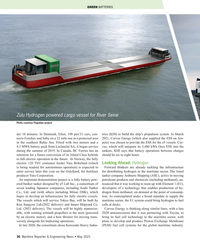 )
May 2021 - Maritime Reporter and Engineering News page: 36
)
May 2021 - Maritime Reporter and Engineering News page: 36the stern (powered 2020 announcement that it was partnering with Toyota, to by an electric motor), and a bow thruster for moving trans- bring its fuel cell technology to the maritime sector, with versely alongside for bunkering operations. plans to develop and produce Proton Exchange Membrane In late 2020
-
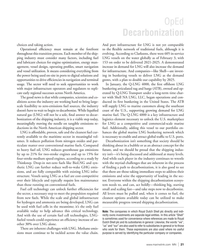 )
March 2021 - Marine News page: 21
)
March 2021 - Marine News page: 21within the shipping decarbonization ecosys- than those running on conventional fuels. tem needs to, and can, act boldly—thinking big, starting Fuel cell technology can unlock further ef? ciencies for small and scaling fast—and take steps now to decarbonize. the sector, a necessary step to meet the propulsion
-
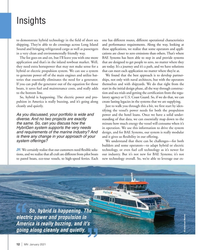 )
January 2021 - Marine News page: 12
)
January 2021 - Marine News page: 12both builders and some operators—to adapt hybrid or electric JH: We certainly realize that our customers need ? exible solu- technology, or even fuel cell technology as it’s newer for tions, and we realize that all craft are different from pilot boats our industry. But it’s not new for BAE Systems; it’s
-
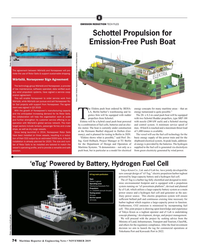 )
November 2019 - Maritime Reporter and Engineering News page: 74
)
November 2019 - Maritime Reporter and Engineering News page: 74is available. Since being launched in 2014, Norsepower Rotor Sails many), and is planned for testing in Berlin in 2020. The vessel will use the fuel cell technology for the have been installed on three vessels, resulting in a reduc- “Elektra shows what is possible,” said Prof. Dr.- basic energy supply of
-
 )
November 2019 - Marine News page: 94
)
November 2019 - Marine News page: 94construction at the Hermann Barthel shipyard in Derben (Germany), will be the ? rst emission-free push boat worldwide. The vessel will use the fuel cell technology for the basic energy supply of the power train and for the shipboard electrical system. At peak loads, additional energy is provided by batteries
